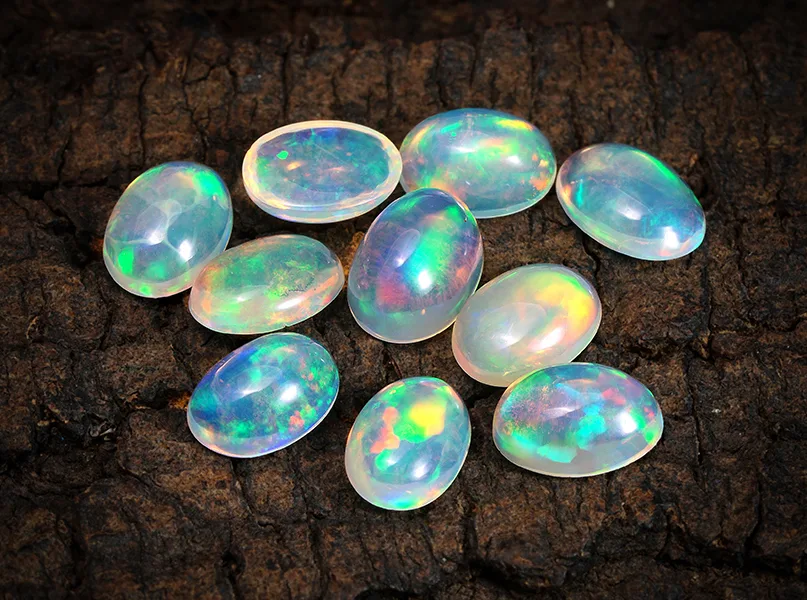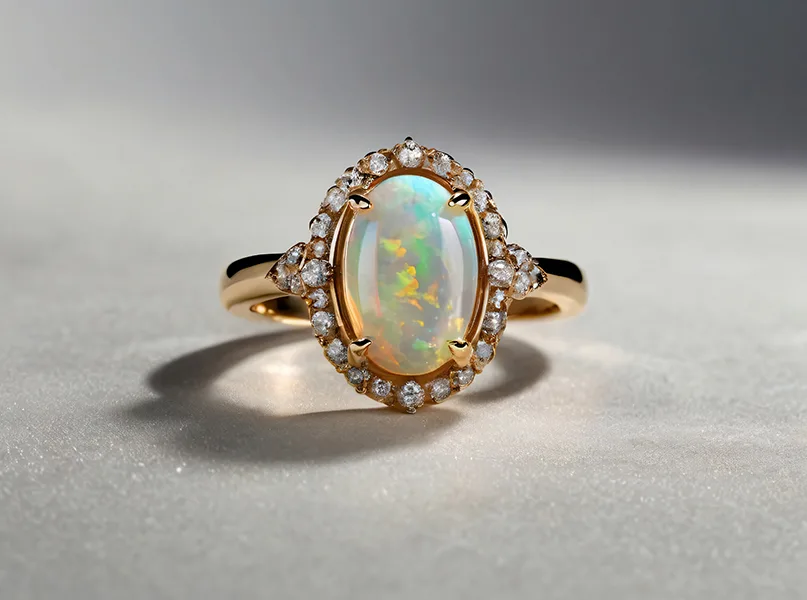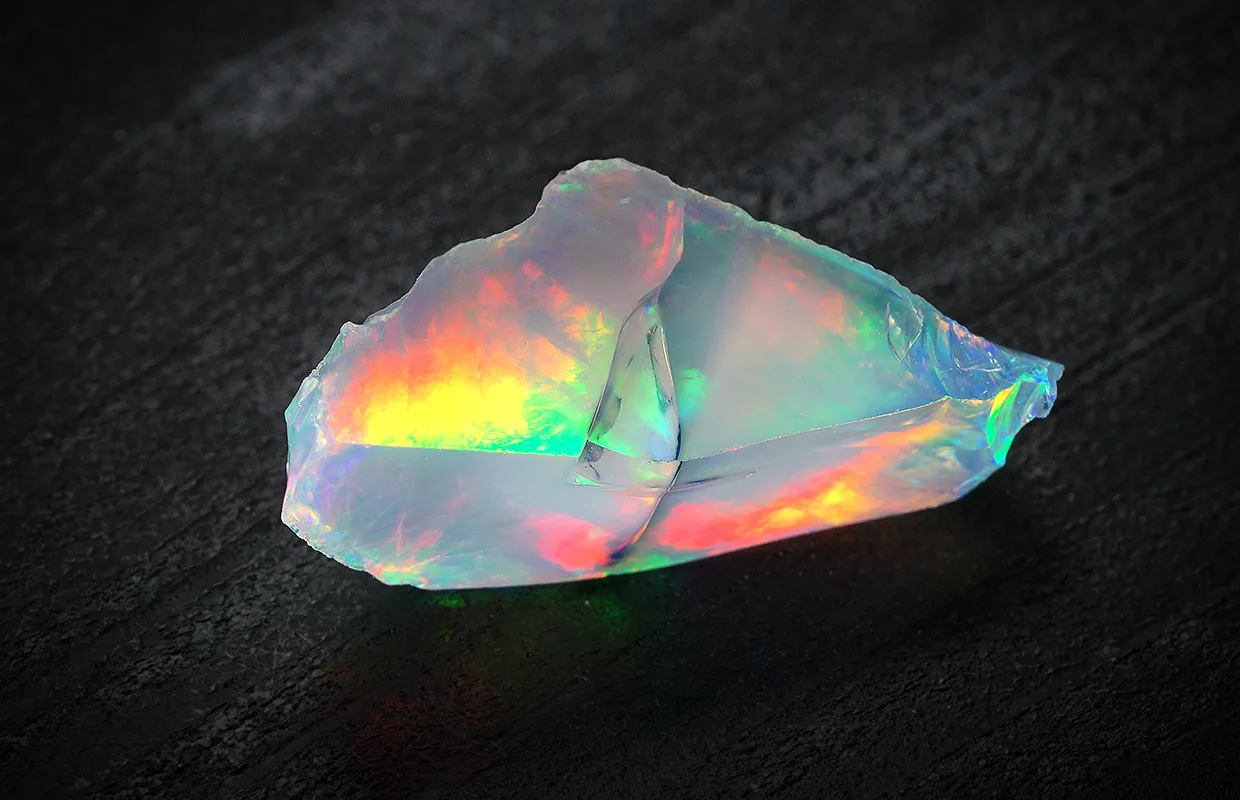The enchanting world of opals captivates the spirit, as their radiant colours inspire creativity, intertwining profound historical significance with symbols of hope. We explore the journey of these magical gemstones and their resurgence in modern culture.
DIGGING DEEP INTO OPAL MINING
Once highly coveted by the European aristocracy for their ethereal beauty, opals are considered one of the world’s most magical gemstones.
Indeed, the Emperor of France, Napoleon Bonaparte, gifted his wife Josephine an opal dubbed ‘The Burning of Troy’ due to its intense red nature raging against a black base – it was her favourite offering from her husband.
The iridescent qualities and mesmerising kaleidoscopic colours of opals have led many cultures to attribute them with supernatural powers, adding to their allure.
Producing prismatic flashes when illuminated, each stone is as diverse as a snowflake, showcasing unique patterns and plays of colour, with dominant hues and intensity as well as transparency marked by the presence of matrix, crazing, and pits.
An opal can display a single colour, two or three, or all the colours of the rainbow. Often divided into types based on their background, there are many different categories of these gemstones.
However, the five main types are black, white, fire – which is usually yellow, orange, or red; boulder – which is translucent to opaque within a host rock called a matrix to which it is attached, making it part of the finished gem; and crystal – which is transparent to semi-transparent with a clear background.
Patterns include pinfire or pinpoint – small and closely set patches of colour; harlequin or mosaic – broad and angular with closely set patches of colour; flame – sweeping reddish bands or streaks that shoot across the stone; and peacock – mainly blue and green.
There are two varieties of opals, the first of which are precious gems that are opalescent to varying degrees, resulting from the spaces between amorphous hydrated silica spheres that form within the stone’s internal structure.
These allow light to pass through and create vivid, colourful refractions; in contrast, there are common opals, which are simpler, displaying a hazy, milky sheen.

MINING MAP
Opals are mineraloids that form through the gradual natural heating of silica gel found in cracks within rocks.
Although they were once considered rare, the discovery of rich opal mines in Australia has changed that. Today, the country produces 95 percent of the world’s supply; as a result, it is not surprising that opals are the national gemstone of the country.
Before the discovery in Australia, the opal mining map included areas in Ethiopia, the Western US, Mexico, Brazil, Honduras, Slovakia, Indonesia, Tanzania, and Peru.
The gemstones were discovered in the semi-subterranean town of Coober Pedy around 100 years ago. Located in the Australian desert, it takes its name from the Kokatha words ‘kupa piti’, meaning ‘white man’s hole’.
Despite the absence of large mining companies in the area, it manages to supply the majority of opals exported from Australia. Locals use a variety of machinery to excavate their small plots, and residents who cannot afford expensive equipment sift through mounds of earth using machines left behind by previous miners.
Opals are among the few gemstones that can be economically mined by just a couple of individuals. In the early days, miners used a simple method of shaft sinking, employing only a pick and a shovel; once they discovered promising opal dirt, they would branch out sideways.
Horizontal excavations were carried out using picks and explosives, and the gem was then carefully extracted using a handpick or screwdriver.
Most mining involved two men – one in the hole and another at the surface to operate the windlass and haul out the dirt. Today, the majority of shafts are sunk using Calweld-type drills following a rapid increase in the use of machinery in the 1970s, including tunnelling equipment and small underground front loaders.
Utilising technology streamlines operations and increases production, although it can sometimes have unintended consequences if it shatters the stone.

AN OASIS OF OPALS
After a period of decline, the Australian opal market is poised for a turnaround thanks to increased production from both existing and new deposits, which are primarily exported to Hong Kong, Taiwan, Japan, Europe, and the US.
Australia dominates the opal industry, supporting numerous local communities and attracting substantial tourism, which significantly contributes to the country’s economy.
Renowned for producing high-quality and valuable gems, the opal fields are located in three states along the Great Artesian Basin (GAB) – South Australia (SA), New South Wales (NSW), and Queensland.
Four Australian opal mining towns – Coober Pedy, Andamooka, White Cliffs, and Lightning Ridge – have become household names.
As the world’s leading source of the finest opals, Australia boasts a harsh outback that features a unique combination of geological conditions, allowing for the formation of gemstones near the margins of the Eromanga Sea, a vast ancient inland sea that formed the GAB – one of the largest underground freshwater resources in the world.
However, the future of Australia’s opal mining industry remains uncertain due to regulatory changes in regions such as NSW, which have limited mining activities.
The closure of opal mining towns, such as Mintabie in SA, has also affected livelihoods, whilst environmental concerns have arisen as the industry shifts towards more sustainable practices.
To address these challenges, exploring potential new deposits, promoting the captivating beauty of opals to increase their market relevance, and developing innovative mining techniques for environmentally-friendly operations could help preserve Australia’s opal heritage.
SPIRITUAL SIGNIFICANCE
The ancient Greeks believed that opals possessed the remarkable ability to grant their wearers the gift of prophecy whilst also protecting against disease.
This reverence for the stone continued throughout history, with Europeans viewing opals as symbols of hope, purity, and truth. In ancient Rome, opals were particularly cherished, often associated with love and known as the cupid stone, further enhancing their power.
Arabic legends contributed to this sense of wonder, describing opals as celestial gifts that descended from the heavens in flashes of lightning, imbuing them with otherworldly powers. Traditional folklore paints the opal as an enigmatic gem intertwined with nature, symbolising rainbows, butterflies, and hummingbirds – a testament to its vibrant beauty.
Amongst the Aztecs, fire opals held a sacred place, named after their feathered serpent deity, Quetzalcoatl, and were believed to embody creativity and signify new beginnings. Similarly, in medieval Europe, there was a strong belief that opals could grant invisibility or offer divine protection, illustrating their enduring mystique.
Despite its mysterious charm, the opal experienced a decline in popularity during the 1800s, largely due to a passage in Anne of Geierstein, a Gothic novel by Sir Walter Scott, in which the gemstone is portrayed as talismanic with supernatural powers, influencing the plot and altering its reputation.
In the book, a character’s death caused by an opal ultimately solidifies the superstition that they are unlucky unless worn in their birth month of October.
However, the negative connotations diminished as new deposits were discovered, revealing previously unseen colour schemes, and their popularity rebounded. Queen Victoria’s fondness for opals during the Victorian era contributed significantly to their resurgence, and they were favoured by Art Nouveau jewellery designers from 1890 to 1910.
In 1954, Queen Elizabeth II received a spectacular Andamooka opal necklace and earring set from the South Australian government on her Commonwealth tour.
Today, in some Asian cultures, the gemstones are associated with good luck and fortune in business, whilst modern gemstone enthusiasts often associate opals with healing properties and spiritual awareness.




































